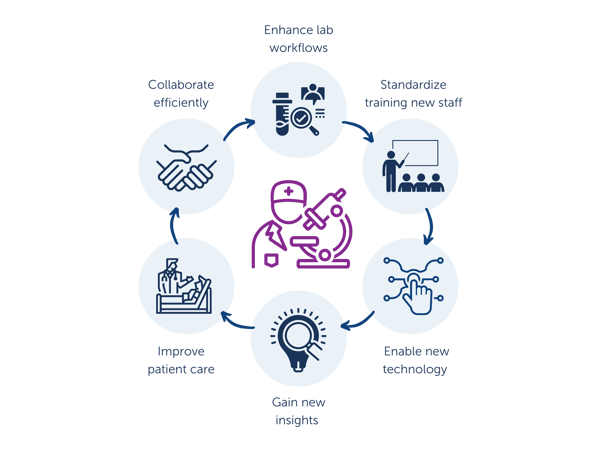Digital pathology has become widespread across the world in more than just academic labs. Contract research organizations (CROs) and pharmaceutical companies reap the benefits of digitization due to the nature of their work which is managing and analyzing millions of samples while seeking to reduce cost and time to develop viable drug candidates. Clinical labs on the other hand find it particularly helpful for producing quantitative results and taking part in remote diagnostic consultation.
The benefits of digital pathology
The benefits of digital pathology are manifold, the following graph summarizes these for the general pathology lab. These benefits are applicable to all areas and industries including academic research, preclinical labs of pharmaceutical companies and CROs, as well as the clinical pathology laboratory.
- Enhance lab workflows. Labs that use traditional image analysis methods often suffer from bottlenecks and delays. By digitizing their pathology practices, labs can streamline their workflows allowing them to take on larger caseloads while actually reducing turnaround times.
- Standardize training new staff. Another logistical problem ameliorated by digital pathology is the time it takes to train new pathologists or specialists. Digitized learning materials and digital training resources remove the need for manual preparation and allow for higher quality materials to be shared consistently with more than just one person at a microscope at a time.
- Collaborate efficiently. Sending physical slides via snail mail is no longer required when samples are digitized. This is particularly important as clinics, labs, and research organizations are working in a more multidisciplinary manner. Remote consultation, collaboration and even remote education are seamless with digitized images, particularly when viewed and shared via a cloud-based software such as Aiforia.
- Improve patient care. Particularly beneficial to clinical labs, many digital pathology systems and software enable integration with hospital information systems and patient registries. Connecting clinical patient information to the data obtained by the pathology lab enhances the ability of healthcare professionals to provide personalized care.
- Gain new insights. Whole slide images can be viewed in high quality on a computer screen and software that allow fluid panning and zooming enabling pathologists to essentially see better and to see more. These viewing functionalities combined with artificial intelligence (AI), such as Aiforia’s deep learning AI, can enable users to discover patterns or markers they may have missed if using traditional, manual methods.
- Enable new technology: The digitization of samples has set the scene for computational image analysis technology and software to be used. Artificial intelligence is one the most prominent technological advancements to come after the invocation of digital pathology. AI-assisted analysis itself brings more benefits: improving accuracy, speed, and image analysis workflows even more. Find out more about the use of AI in digital pathology.

Adopting digital pathology
Nothing can replace the pathologist. However, these superheroes of medicine deserve better tools in their hands. Digital pathology and AI systems help unlock the full potential of pathologists not only assisting them but also affecting patient care and treatment.
Waiting times for results can be decreased, information from tissue samples can be connected and catalogued with clinical data bringing about a better understanding of disease and patient populations, while precision medicine and personalized care become more prominent. The digital evolution has arrived in the field of pathology, is your lab ready?
REFERENCES
Pantanowitz L. Digital images and the future of digital pathology. J Pathol Inform 2010.
Pantanowitz L. Digital Pathology. In: Pantanowitz L, Parwani AV, editors. Chicago, USA: ASCP Press;
https://www.ncbi.nlm.nih.gov/pmc/articles/PMC6289005/
https://www.rcpath.org/profession/digital-pathology.html